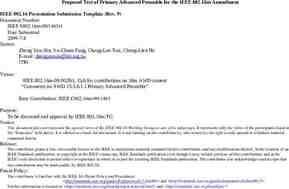THE HISTORY OF LIFE INSURANCE REGULATION For Financial Professional
12 Slides473.87 KB

THE HISTORY OF LIFE INSURANCE REGULATION For Financial Professional Use Only

UNIVERSAL LIFE INSURANCE INTRODUCED IN 1979 No Regulation Tax Shelter RED FLAG! For Financial Professional Use Only

Congress Act:1 The Tax Equality and Fiscal Responsibility Act (TEFRA) of 1982 Passage of the Tax Equity and Fiscal Responsibility Act (TEFRA) in 1982 established that universal life insurance was, in fact, life insurance. The law defined characteristics of life insurance that must be present. Beyond this, TEFRA didn’t do a lot. While many in the life insurance industry were holding their breath while this legislation was hammered out, the ultimate impact was minimal. It wasn't until two years later that legislators used this legislation and new legislation to slap the first set of real “handcuffs” on life insurance. For Financial Professional Use Only

Congress Act:2 The Deficit Reduction Act (DEFRA) of 1984 The Deficit Reduction Act (DEFRA) of 1984 coordinated with language laid out in TEFRA from two years before to establish specific rules about what life insurance was and what life insurance was not. More specifically, upon DEFRA's passage, we now had specific limitations on premium size relative to an outstanding death benefit. That Premium to Death Benefit ratio was now the deciding factor as to what qualified or disqualified a life insurance contract as life insurance. DEFRA included the creation of two tests that would be the guideline moving forward for life insurance qualification & created the inception of the 7702 tax code. The Cash Value Accumulation Test (CVAT) Guideline Premium Test (GPT) For Financial Professional Use Only

2015 – Introduction of AG49 by the NAIC Prior to 2015: -Life insurance illustrations could be presented in the same manner as annuities, using a “cherry picked” sequence of returns. -Using these “cherry picked” sequence of returns combined with a low loan rate(in a low interest environment), allowed the carriers to show very large arbitrage numbers. -Deceptive illustrations. Using returns from a timeframe when interest rates were high (meaning higher caps and pars), and putting them against loans from a more current, lower interest rate environment. For Financial Professional Use Only

2015 – Introduction of AG49 continued What Changed? -No more “cherry picked” sequence of returns. Carriers now obligated to illustrate a level, average crediting rate based on their S&P 500 core index account. Calculated on a 25 year daily rolling period going back to 1949, with historical caps applied. -Limited the amount of arbitrage that’s allowed to be shown in an illustration to 1%. -Created the requirement for additional disclosures to be included in IUL illustrations that are not required in non-Indexed UL products. For Financial Professional Use Only

The Illustration Game Begins In response to the new AG49 regulations, carriers created index accounts with “multipliers”. The multipliers were percentage-based bonuses to index crediting. By using these multipliers, the carrier could then add the additional crediting from the multiplier into the life insurance illustration. The additional crediting from the multiplier was being used to prop up the arbitrage numbers to the max 1% that could be shown. The multipliers were NOT guaranteed elements of the life insurance contract. For Financial Professional Use Only

2020 – AG49a is Introduced -Expanded upon the previous guidelines to further restrict what can be shown on life insurance illustrations. -By limiting how products with interest-linked rate enhancements can be illustrated, essentially doing away with the multiplier concept. -Further restricted the amount of arbitrage that could be shown, lowering the acceptable illustrated arbitrage from 1% to .50%. For Financial Professional Use Only

Carrier Response to AG49a The Illustration Game Continues -Upon removing their “multiplier”, the carriers redesigned their index models to include flat bonuses. Depending on the carrier, the bonus could range from 50 bps to 3 bps. -These flat bonuses are still non-guaranteed elements of the life insurance contract. -Persistency bonuses flood the market. Carriers start adding bonuses to the product based on account value, not index returns. Sometimes referred to as a reimbursement of expenses. -Non-guaranteed elements of the life insurance contract. For Financial Professional Use Only

2021 - Finally Some Good News The Consolidation Appropriations Act -The Consolidated Appropriations Act revised and lowered the required corridor for life insurance under federal guidelines. -The same premium contribution could now have a significantly lower face amount attached to it. -Huge benefit to cash accumulation and income planning because you have less stress on the policy from the cost of the death benefit itself. For Financial Professional Use Only

Timeline Review 1. 1979 – Introduction of Universal Life Insurance 2. 1982 – Tax Equity and Fiscal Responsibility Act 3. 1984 – The Deficit Reduction Act 4. 1988 – The Technical and Miscellaneous Revenue Act 5. 2015 – Actuarial Guide 49a 6. 2020 – Actuarial Guide 49b TEFRA 7. 2021 – The Consolidated Appropriations Act Introduction of Universal Life Insurance 1980 AG49a You Are AG49b Here 2015 2020 TAMRA DEFRA 1985 1990 1995 2000 2005 For Financial Professional Use Only 2010 The Consolidated Appropriations Act 2025

Life Insurance Regulation is Constantly Changing Stay Informed! Either take the time to follow regulatory changes, or make sure you have the right FMO behind you! Be Malleable & Innovative! Based on regulatory changes, the way you design a life insurance policy tomorrow may be different than the way you design a life insurance policy today! The Bright Side? Life Insurance regulations are grandfathered into a policy when it is issued. Meaning that new regulations DO NOT have an effect on policies previously sold. Whatever the regulations were at the time of sale will govern for the life of the policy. So, while the rules may change again moving forward, you can feel free to sell with confidence now! For Financial Professional Use Only






